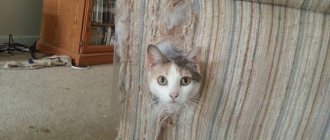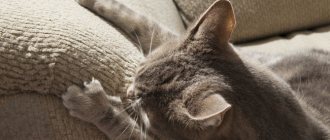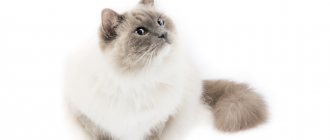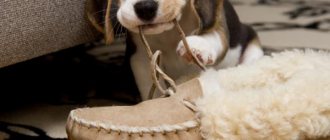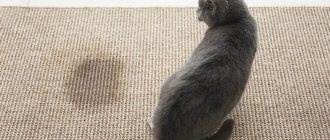How to stop a cat from tearing up furniture
There are many ways that can help you stop your pet from scratching furniture. Let's start with the most popular ones.
Loud sounds, voice command
Every time the cat tries to sharpen its claws on interior items, loudly and sharply say “No!”, “No!”, “Shhh!” Continue this until the pet retreats from its goals.
Note! You shouldn't swear at a cat when it has already sharpened its claws. Do this before or in the first seconds of turning, so that this activity is associated with punishment. The cat must understand why exactly you are scolding him.
The cat must understand why it is being scolded.
Another effective way to wean it from a “bad” habit is ordinary baby rattles . You can buy a rattle or make it yourself - for example, put a few coins in a metal jar (found in the kitchen), seal it and always keep it near you. Noticing that the cat wants to do some mischief again, take the can and rattle it loudly. The animal will quickly run into the next room, because it does not like such strong sounds. Rattle every time to reinforce the learned material!
Balloons are another good “sound” parenting method, although not the most convenient for the owner. Inflate and tie several balloons and secure them at the crime scene. The trap must be designed so that one of the balls bursts during the next claw point. The loud sound will scare away the animal and the next time it will be afraid to approach the ill-fated chair.
The cat is tearing up the furniture
Spray bottle with water
Cats, as you know, do not like water procedures, so why not take advantage of this? Fill a container with a spray bottle with water and spray your pet every time he intends to sharpen his claws in a prohibited place. But do not forget that such a “shower” is effective only before the incident or within five minutes after it, otherwise the animal simply will not understand why it is being punished. Unpleasant sensations, as in the previous case, should be associated with a “crime”.
Spray bottle with water
We arm ourselves with... smells!
Representatives of the cat family cannot tolerate the aroma of onions, vinegar and citrus fruits. It is better to give preference to the third option, since the vinegar disappears quite quickly, and the smell of onions will be unpleasant for you. Mix lemon (orange, tangerine) aromatic oil with the same amount of eucalyptus in a container with a spray bottle. Spray furniture, wallpaper or other necessary items with the resulting solution. The advantage of this method is that it will not only wean the cat from tearing up furniture, but will also fill the home with pleasant odors.
Lemon oil
In addition to citrus fruits, you can use various spices. Pour coriander, ground chili pepper or other strong-smelling seasonings into the bag, then hang it (the bag) in the desired place.
Sticky surface
The feeling of stickiness is just as unpleasant for cats as water procedures, and therefore you can stick double-sided tape on the most attractive places (for example, armrests, the back of furniture).
You can also use special adhesive tape Sticky Paws (translated as “sticky paws”), which can be glued almost anywhere - on the carpet, upholstery, curtains. Such tapes are practically invisible, and therefore will not spoil the interior of the room.
Sticky Paws Cat Tape
Nail trimming
When trimming the sharp part of the claw, you must act with extreme caution, otherwise you may harm your pet. It is advisable to entrust this matter to a qualified veterinarian. Although it is quite possible to learn how to trim your claws yourself. You just need to do this to a certain length and at the required angle, using exclusively special scissors.
Scissors for trimming cat claws
Important! It is strictly not recommended to use scissors for dogs! The shape of the claws of these animals is different! And after trimming, be sure to reward the cat so that the process is not just torture for him.
Proper trimming of cats' claws is the key to the success of the entire procedure.
Closed doors
If there are any expensive items in the room, keep the doors closed as soon as the cat arrives. Choose a type of doorknob that will not open if the animal pushes with its paws.
Door lock
Or you can make such a device at the bottom of the door leaf.
Screw at the bottom of the door
Video - How to stop a cat from tearing up the sofa and wallpaper
scratching post
An excellent solution to the problem. Typically, you can make a scratching post with your own hands, but to do this you need to take into account several important nuances.
- The place should be as comfortable as possible for the pet.
- The height should correspond to his height.
- The scratching post must be secured securely so that it can withstand the load.
- The top layer should be made of a rough material of medium hardness, reminiscent of tree bark. An excellent option is sisal rope, although you can use other materials.
Scratching post on the wall
The cat always considers himself the master of the house, and therefore is unlikely to limit himself to just one place to demonstrate his power. If you have a large apartment or you are the happy owner of several cats at once, it is better to place 2-3 scratching posts where the animals most like to be.
Kittens and scratching post
Scratching posts for cats
Why do cats scratch textiles and wallpaper?
Nature gave cats claws for a reason. They play an important role in the life of an animal: they help to grab the desired object and hold it for as long as possible. Another option is for the animal to be held using its claws on various inconvenient surfaces.
Claws perform another important function: the animal uses them to mark territory. The thing is that the spaces between the paw pads have glands. And the glands produce pheromones, which send signals to other cats in the area - there is already an owner here.
Another reason for sharpening claws is to relieve stress. For example, when very frightened, upset or overexcited, a cat scratches an uneven surface, thereby “letting off steam.”
Finally, overgrown claws simply get in the way of the cat. If she is not accustomed to a special scratching post, furniture or joints in the house will definitely suffer from her paws.
All these “good reasons” are listed to make it easier to understand how to stop a cat from tearing up furniture. It is not so easy to discount hundreds of thousands of years of evolution and innate instincts.
Making a scratching post with your own hands. Master Class
Let's look at one simple and inexpensive way to make a cat simulator. To do this, prepare in advance:
- a round wooden plate (ø35 cm), cut it out before starting work;
- tape (yellow, pink or white);
- wooden beam (40x40 mm) 0.7 m long;
- scissors;
- electric drill, screwdriver, and wood screws of sufficient length;
- glue, construction stapler;
- white cover (40x40 mm), these are used for switches;
- white paint;
- nylon rope (50 m);
- fabric dye (yellow or pink).
A beautiful scratching post made from scrap materials
Step 1. After preparing everything you need, you can start making your own scratching post. First, secure the beam in the center of the base. It is important to accurately determine the center of the circle, otherwise the appearance of the entire product may be spoiled. After fixing, paint the circle with white paint.
The post is attached to the center of the base
Step 2: Start painting the rope. By the way, this rope is lighter in color and therefore better than sisal or jute. Although nylon itself is less durable, this is not so important - scratching posts do not last very long, their service life (both homemade and purchased) is limited.
Painting nylon rope
Step 3: When dyeing, follow the instructions that came with the fabric dye. Then the rope should dry thoroughly, for which it can be laid, for example, on a radiator. This may even take the whole night, so it is better to postpone further work until the next morning. Moreover, during this time the smell of the paint with which you painted the round base will have time to disappear.
The rope must dry well
Step 4. You can start winding. To begin, nail one end of the rope to the block, as shown in the photo below. Also be sure to spread the glue all over the post. If you use ropes of different colors, connect them using colored tape (pink on the pink area, etc.). Seal the joint between pink and yellow with pink tape, which will look like a continuation of the pink edging. This is why you don’t need to buy tape in all three colors.
The post is wrapped with rope
Step 5. Secure the second end of the rope on top with the same stapler, and cover the remaining area with a plastic cover. In the absence of the latter, simply paint the area or decorate it as you wish.
The remaining area is covered with a lid
Step 6. The scratching post is ready for use! If you don’t have the time/energy/desire to make this option, you can try making another one (step-by-step instructions are given below).
Photo of the finished scratching post
Table. Making a scratching post from corrugated cardboard.
| Steps, photo | Description of actions |
| Step 0 | To begin, prepare everything you need - thick corrugated cardboard, a screwdriver, a template with diagrams of all levels of the future design, an electric drill, a wooden dowel, a knife for cutting cardboard, screws, plywood, as well as a convenient surface on which you will cut the levels. |
| Step 1 | Mark the center of the plywood base. Take a drill and, placing plywood between a pair of chairs, drill a hole at the mark. |
| Step 2 | Next, using the same drill, drill a hole in the center of the dowel, as shown in the image. This hole will make the next step much easier for you. |
| Step 3 | Take a screw, screw it into the board, and then screw the wooden dowel to the plywood base. Holding the screw with a screwdriver, take the dowel with your other hand and screw it (the screw) to it. It is important to hold the dowel until it is screwed tightly. Manually screwing in the dowel allows you to control the process and, as a result, fix the element straight. |
| Step 4 | Start cutting out the templates. Prepare in advance and then print out templates for all seven levels of the future product. Templates should be drawn on cardboard and cut out. |
| Step 5 | Take the templates and use them to draw shapes on the corrugated cardboard. |
| Step 6 | Cut out the layers along the contour. Using a knife, use a knife to cut out the cardboard using the drawn outline. It is important that the knife you use is sharp, otherwise you may damage the cardboard. |
| Step 7 | Start assembling all layers. Stretch the cut cardboard layers one by one onto a wooden dowel. There is no need to glue the layers together - this will allow you to replace one of them in the future if damaged. |
As a result, you will get something like this scratching post. As you can see, there is nothing complicated here; the work can be completed in just a couple of hours.
DIY scratching post for cats
Below is another interesting option - a small claw in the shape of a fish . Although you can choose any other shape. The idea is to cut corrugated cardboard into strips 10 cm wide and gradually wrap them around each other. However, all stages of production are shown below.
DIY scratching post in the shape of a fish
If education doesn't help
Sometimes scratching posts do not completely eliminate the problem, so you need to look for alternative methods of dealing with a rowdy pet.
Trimming and filing nails
How to stop a naughty cat from tearing wallpaper and furniture if all previous methods do not help? Perhaps the first thing that comes to mind is to trim the claws and thereby minimize the damage.
To trim claws, purchase a special device - a nail cutter, literally cutting off 1-1.5 mm of the regrown length. The device is quite convenient and allows you not to stretch out the procedure, therefore, the cat does not have time to get nervous.
You need to trim the claws very carefully, otherwise you can remove excess nails and harm your pet. Do not touch the blood vessels - they are located in the pinkish corners that are visible through the light.
Another, more expensive option is to take your pet to the vet. It doesn’t matter whether you have a small kitten or an adult cat: with a specialist, the animal will take the claw trimming procedure more calmly. Moreover, the veterinarian’s actions last no longer than five minutes.
Overhead anti-scratch pads
Anti-scratch caps look like silicone caps: they are attached directly to the animal’s claw using special glue. The glue is made of hypoallergenic substances and does not harm the cat.
Veterinarians warn: not all pets allow themselves to be put on “shoes” for their claws. Sometimes an animal tries to get rid of an incomprehensible attribute on its paws - this is a natural process of self-defense. Over time, the pet gets used to them and does not pay attention. In rare cases, the most active furries chew off the silicone caps, and after 3 hours all the claws are open again. But it’s still worth trying this method, since not all pets react negatively to anti-scratch treatments.
To correctly select the size of the caps, the owner must know the exact weight of the pet. Any pet store will help you choose the necessary anti-scratch pads for your pet using a size chart. You can also order them online: they are inexpensive and look nice.
Insulation of expensive furniture
Listed above are the most common and effective ways to wean your domestic cat from scratching furniture and wallpaper in the house. But it happens that none of the expert advice helped solve the obvious problem.
If your pet turns out to be more cunning and intelligent, try trying other methods of combating the bad habit. One of them is to isolate the attractive surface of upholstered furniture with durable covers made from fabrics that are not suitable for sharpening claws. Even if the cat ruins the bedspread, you can always buy a new one - it’s easier than changing furniture.
Another way is to keep the cat out of the room where it is sharpening an illegal object. Close the door tightly and under no circumstances allow your pet to come inside, even with you. The temptation will disappear and the habit of turning to the scratching post will appear.
Special sprays
Sometimes stopping a cat from tearing up wallpaper and furniture is like winning a war. You need to try all the means for one of them to work. Cats have a sensitive sense of smell, so you can turn to special products from a veterinary pharmacy. If you spray furniture with this spray, the cat will not come close to it.
You can buy a miracle spray at a pet store or prepare it yourself. You can make this remedy from an infusion of spices, a mixture of water with essential oils of citrus fruits, pine needles, rosemary, sage, eucalyptus or lavender.
In practice, many cats continue to tear wallpaper and furniture, even if a whole bottle of special liquid is poured on it. But it’s still worth trying this method - it suits some fluffies.
How to train a cat to use a scratching post?
The “unit” for sharpening claws is usually located where the pet is used to doing it. As mentioned above, if there are several such zones, then there should be the same number of scratching posts (ideally).
- If the animal has its own sleeping place, then the scratching post should be placed there (cats always warm up after waking up).
- You can show your cat how to use a scratching post - first of all, move his paw along the column (this should be repeated several times).
- It is better to cover or take away all distracting objects so that the pet can focus more often on the scratching post.
- Place foil, adhesive tape or slippery plastic on the floor in the place where the cat likes to tear wallpaper or furniture.
Getting the cat used to the scratching post
Note! Every time your pet uses the scratching post, reward him, pet him and give him compliments.
You should not lure your pet to the grinding “unit” with valerian. Having gone crazy, the cat will bury its nose in the scratching post, rub against it, meow loudly and perform various circus acts, without even remembering its direct purpose.
Why does an animal ruin furniture?
There are several reasons why a cat scratches furniture and wallpaper. For example, this is how she performs “physical gymnastics.” By extending and retracting its claws, the pet stimulates the work of the ligaments. It also strains and stretches muscles, kneads joints. The natural need of the feline species is to grind off the upper stratum corneum from the claws, since it will interfere with the animal’s movement and can dig into the pads on the paws. In nature, pets do this with the help of trees, so they may mistake home furniture or wallpaper for a natural scratching post.
There are psychological reasons why a cat tears up furniture:
- Jealousy of other pets or defense of one's territory. On the surface of cats' paws there are special glands that secrete pheromones. The human sense of smell is not able to distinguish this smell, but for animals it means that the territory belongs to the creature that marked it. They can interrupt the marks of other pets with their own.
- A stressful situation in which a cat finds itself can become a reason for property damage. For example, if the animal’s owner has changed or the owner pays too little attention to the pet. Also, cats are always stressed due to moving to another place of residence or getting a new pet. The death of the owner and his long absence from home can negatively affect the animal’s psyche, which also often serves as a reason for scratching interior items.
The reason why an animal scratches furniture is often due to age. Little kittens have not yet been trained in anything, and may simply not know that they should not tear up the sofa or wallpaper. Also, young animals are often very active and playful. They do it out of boredom, to get attention or just to get some exercise.
If you don’t teach a young pet the right place to sharpen its claws, it can get used to damaging upholstered furniture, but it’s much more difficult to wean an adult animal off.
Jealousy of other pets or defense of territory
Stress
Young age
Other methods of raising a pet
Try using other methods - it is quite possible that one of them will help bring your cat to reason.
- Aerosol. Let’s immediately make a reservation about the dubiousness of this option, since usually mustachioed people still continue to scratch furniture treated with special sprays.
Beaphar Stop It repellent spray for cats - Protective covers. They are stretched over furniture not only to protect against pets, but also to cover tattered fabric. According to manufacturers, elastic covers are not very suitable for cat activities due to mobility and low stability. Stretch covers are quite easy to clean and wash, and their cost is noticeably lower than a new chair.
Sofa with cover - "Soft Claws". If you don’t want to bother with covers, rattles, tape, etc., you can pay attention to the animal’s claws. For example, you can put special silicone attachments on the claws of the front paws, which follow the shape of the claw and are attached with glue, but do not hinder reflex movements. That is, the claws will calmly retract and extend. Typically, such caps come off along with the stratum corneum after 2 months, but if desired, they can be re-glued.
Anti-scratch for cats - Declawing. A radical method that only heartless owners resort to. Onychectomy is a surgical operation during which the claws are amputated along with the phalanges of the fingers. As a result, the pet becomes disabled - the coordination of its movements is impaired, the cat constantly loses its balance, cannot stay on heights, its spine hurts, and its posture is disturbed. If such an animal ends up on the street, it will find itself completely defenseless there.
Cat declawing is not a cosmetic procedure, not a “pedicure”, but a serious operation during which the phalanges of the fingers are amputated
What not to do
Most people do not know that their prohibitions and threats do not apply to cats. The animal will always do what it wants, without taking into account your opinion. Therefore, when weaning Vaska from a bad habit, remember some important points.
- You should not resort to any physical punishment (the pet will harbor a grudge and will definitely take revenge on you).
- Shame the cat only during the “crime” (belated lectures will not bring him sense).
- You should not throw away an old scratching post, the smell of which is familiar to the animal (it will have great difficulty mastering a new one).
- Finally, you should not yell at your cat (use intonation, but not volume of voice).
Owners of cats who exercise daily are lucky in this regard, because any tree is a large scratching post, for the use of which no one will swear.
Video – How to stop a cat from sharpening its claws on furniture
Means for repelling cats from wallpaper and furniture
In veterinary pharmacies and pet supply stores you can purchase special repellents that can be used to treat furniture, walls, door frames and other places where cats sharpen their claws. The unpleasant smell of these products disgusts cats, and they avoid the treated areas.
Best scratch repellents:
- Beaphar Stop It Cat is an effective spray for repelling cats from wallpaper, furniture and indoor flowers. Price: bottle 100 ml. – 740 – 890 rub.
- Nature's Miracle, JFC Pet Block Cat Repellent Spray is a concentrated spray based on natural repellents. Price: bottle 236 ml. – 440 – 470 rub.
- Spray Mr. Fresh is a means to prevent cats from tearing wallpaper. Suitable for kittens and cats. Price: 200 ml bottle. – 180 – 280 rub.
- Spray lotion VioVax “Repel? Yes!" – based on natural ingredients, protects furniture and walls from scratching. Price: bottle 180 ml. – 123 – 160 rub.
- Api-San Smart spray - protects against chewing and scratching. Price: bottle 200 ml. – 180 – 265 rub.
How to buy a cat?
If you are interested in whether there are “well-bred” cat breeds in the world, then we have to disappoint you - alas, there are none. But there are some practical tips that will help you when buying a pet:
- buy a three- or four-month-old kitten (the character is already indicated, and the owners probably taught him to use a scratching post);
- give preference to breeds that are focused on communicating with people (for example, British Shorthair) to make it easier to achieve mutual understanding;
- In terms of neatness, a purebred cat can surpass even the most purebred “competitors . But here it is better to purchase an already adult pet, so as not to buy, so to speak, a pig in a poke.
5/5 (7)
Rules for caring for a cat
In order for communication with a small cat to bring mutual satisfaction, it is worth knowing the rules of caring for a four-legged cat, which will not require much effort, but love and patience.
Love your pet!
- The first and main condition is personal space, a place for the animal: this can be a house or bedding on which it will sit and sleep. At the same time, you must not forget to shake out dust and wool from it, and also wash it periodically.
- Feed should be varied, nutrition should be balanced.
- If a cat lives in an apartment, from the first days of his life he needs to be trained to use a litter box.
- The coat requires care, especially if the cat is a long-haired breed.
In parallel with accustoming the cat to the scratching post, wean the cat from the places it habitually scratches.
These simple tips will help you raise a gentle, obedient and neat animal that will thank its owner for its care with a gentle purr.
What not to do
One cannot be inconsistent in weaning an animal from a bad habit. This means that it is useless to scold the cat once for a mistake, and a second time to ignore it. Every crime noticed must be punished.
You cannot hit a cat; you can scare it with a slap of a towel or rolled up paper. The animal will not experience pain, but will feel the effect of surprise - as in the case of a loud shout or the ringing of a rattle.
An animal cannot be punished by being locked in a room, left without food or drink - it will definitely not understand why such harsh methods were applied to it, and will only suffer. Particularly sensitive people may become ill due to a bad attitude.
And of course, in no case should you wean your cat from damaging furniture or wallpaper if there is no place in the house specially equipped for these matters. A cat will not be able to avoid sharpening its claws at all: this is the same need as eating, drinking, sleeping and relieving itself. Therefore, scolding a cat before purchasing or creating a scratching post is pointless.
Sprinkle with water
Once your cat has mastered the scratching post, start moving her away from places where her claws should not be sharpened. A completely painless repellent is to spray water from a spray bottle at the moment when it begins to scratch the furniture. The cat will associate unpleasant sensations with its actions and will stop approaching this place.
Buy anti-scratches
If all else fails and your furry pet is still scratching your furniture, try a funny invention - anti-scratch pads. These are small silicone caps that are glued to a cat's claws. They hold on to the claws perfectly until they grow back. They can then be re-glued. At the same time, the cat can calmly scratch the furniture without leaving any marks on it. Anti-scratch pads not only protect furniture from cat claws, but also look funny - almost like a manicure!
Make sticky surfaces
It is also known that cats do not like sticky surfaces. Therefore, another idea: you can stick double-sided tape on the “wrong place”. There is also adhesive tape that has a transparent base and will not be very noticeable on interior details. Once your pet has become accustomed to this area, the tape can be removed.
Say sharply: “You can’t!”
First, try to influence psychologically. As soon as your cat gets the idea of scratching furniture or walls, loudly and sharply say “No!” or “You can’t!” You can even clap your hands or hiss so that the cat immediately reacts to the sharp sound and changes its mind about doing its job. If you are persistent and notice her intentions in time, then you won’t even need to use our other 6 ideas. If you missed the moment or the method did not work, read on.
